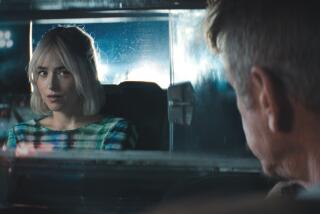‘Letters From Fontainhas: Three Films by Pedro Costa’
For a small group of diligent cinephiles, Criterion’s “Letters From Fontainhas: Three Films by Pedro Costa” is one of the most anticipated DVD releases of the year, or the last several. Costa’s films -- he has made seven features in the last two decades -- have received scant distribution in the U.S., and before this week, none were available on video. But film journals and online critics have brought back the word from international film festivals that Costa deserves a place alongside such festival favorites as China’s Jia Zhang-ke.
The epistolary title of Criterion’s four-disc boxed set, which includes “Ossos” (1997), “In Vanda’s Room” (2000) and “Colossal Youth” (2006) as well as more than four hours of supplementary materials, is a clue to the films’ origins. After shooting his second feature, “Casa de Lava,” in the African country of Cape Verde, Costa was deluged with letters from cast and crew, who hoped he’d deliver them to relatives in the Fontainhas section of the director’s native Lisbon. Fulfilling that request meant exploring, and getting lost in, a decrepit but brightly colored slum -- home to some 200,000 immigrant Cape Verdeans as well as drug addicts and the dispossessed from all over Portugal.
He grew fascinated with the well-known-but-little-observed area, and cast “Ossos” in part with nonprofessionals he met on Fontainhas’ streets. His most enduring discovery was a lanky, volatile heroin addict named Vanda Duarte, who plays a central role in all three films.
Among the three films, “Ossos” hews the closest to a conventional narrative and is also the only one to be shot on 35mm film rather than consumer-grade video. But even here, the story of the shifting relationships between a pregnant teenager (Mariya Lipkina), her wayward boyfriend (Nuno Vaz) and her elder sister (Duarte) feels like a pretext for setting up shop in their lives. Whether using film or video, Costa films in static, carefully framed shots, often with minimal dialogue, allowing (or if you like, forcing) us to adapt to the rhythms of life in Fontainhas.
That strategy is carried to greater and more demanding lengths with “In Vanda’s Room,” for which Costa drops the pretense of fiction and employs a more elusive pretense of real life. Notwithstanding its long stretches of real time and its washed-out video palette, the film is hardly a documentary; Costa culled the three-hour movie from 180 hours of tape, often doing dozens of takes of a single scene. In it, Duarte plays a character named Vanda, her sister and mother are played by her sister and mother, and the conversations among them go on at a length that even seasoned professionals would have difficulty with. Their speech can be harsh and matter-of-fact or lend itself to sudden flights of lyricism, a dichotomy reflected in the interplay between the movie’s beautifully composed frames and the degraded video Costa uses to shoot them.
The turn toward video had much to do with the practical difficulties of maneuvering lighting trucks through Fontainhas’ narrow streets and a sense that there was something not quite right about disjuncture between the expensive equipment used to shoot “Ossos” and the extreme poverty in front of the lens, but Costa embraces the disreputable medium rather than treating it as a necessary compromise. When a pair of junkies close their shutters just before shooting up a midday fix, Costa keeps shooting in candlelight, a few yellowish blobs all that is visible in a sea of pixelated night.
“Colossal Youth” focuses on the towering figure of Ventura, a sad-eyed Cape Verdean who seems to have fathered half of Fontainhas, including several characters from earlier films. (The film’s Portuguese title translates as “Youth on the March”; Costa’s English title is taken from an album by the minimalist post-punk group Young Marble Giants.) The demolition of Fontainhas, which forms a steady refrain in the previous film, is nearing its end, and the residents are being relocated to sterile public housing units, but Ventura wanders the ruins almost like a ghost, repeating the text of a love letter to his vanished wife.
The film’s logic has as much to do with architecture as narrative, a movement from personalized squats to quasi-middle-class uniformity. By the time the trilogy’s full weight has sunk in, the transition takes on a melancholy air, a profound sense of loss muted slightly by the fact that the films survive, even though the slums of Fontainhas do not.
More to Read
Only good movies
Get the Indie Focus newsletter, Mark Olsen's weekly guide to the world of cinema.
You may occasionally receive promotional content from the Los Angeles Times.






